The last day of the expedition had arrived. I couldn’t believe it had come. Two weeks previously, with all the uncertainties and potential dangers ahead, I would have traded places with this day in a blink of an eye – now I would gladly have gone back two weeks.
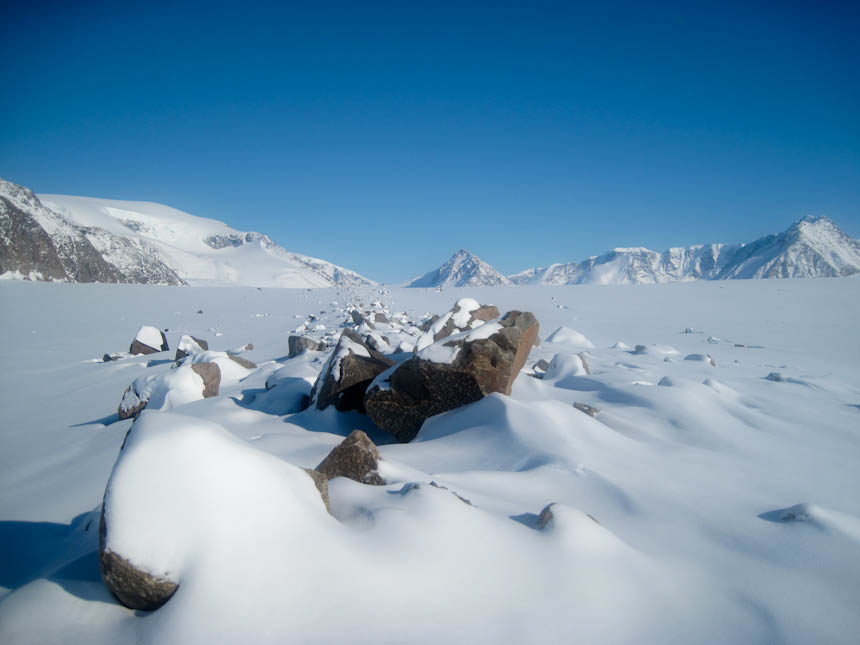
But still there was a large part of me that was glad that it was almost over. It was hard not to relax and to keep our guard up. ‘It’s not over until it’s over’ is what we had to tell ourselves, and as we woke up that morning we realised that the Arctic wasn’t going to let us go so easily. Blizzard – whiteout conditions. We were only 10km from Pangnirtung, the Inuit community that would be our last stop, and yet in a whiteout even 1km can become impossible. Visibility was down to only a few metres, we were in prime polar bear territory and we were heading to the floe edge – open water.
We had indeed crossed the Penny Ice Cap, making the first British crossing and opening up a new access route onto the ice cap itself. We had had difficult terrain getting onto the ice cap – climbing and traversing 30-40 degree slopes whilst dragging heavy equipment behind us. Such terrain we did not take lightly and opted for caching kit and going back two, three and sometimes even four times to keep the loads (and the danger) down. We had high winds on the ice cap – forcing us to construct shoulder-high walls each night to take shelter behind. At one point we were bent double fighting against a head-on wind that gusted at over 70km/h. Finally we had lived for 17 days and nights in temperatures never warmer than -10C and often below -20C, travelling over 250km, and climbing and descending 2000m well away from any human contact.
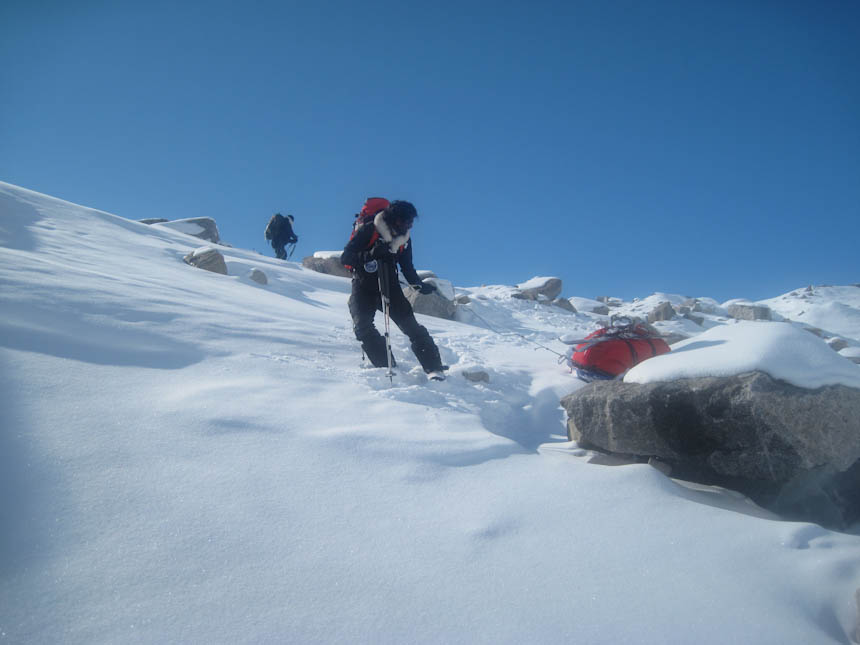
After all this, and only 10km from the end, it was thus hard not to be complacent. We ate breakfast and packed our pulks for the last time, and moved off into the white. We used the GPS as a backtracking tool to check our progress. The straight line between the front, middle and rear person is meant to help show whether a straight line is followed, but the whiteout disorientates and confuses. Often our progress was as much as 90 degrees out of our intended direction, and with the wind and snow to contend with our meandering progress was slow. But it was only 10km – no problem, right?
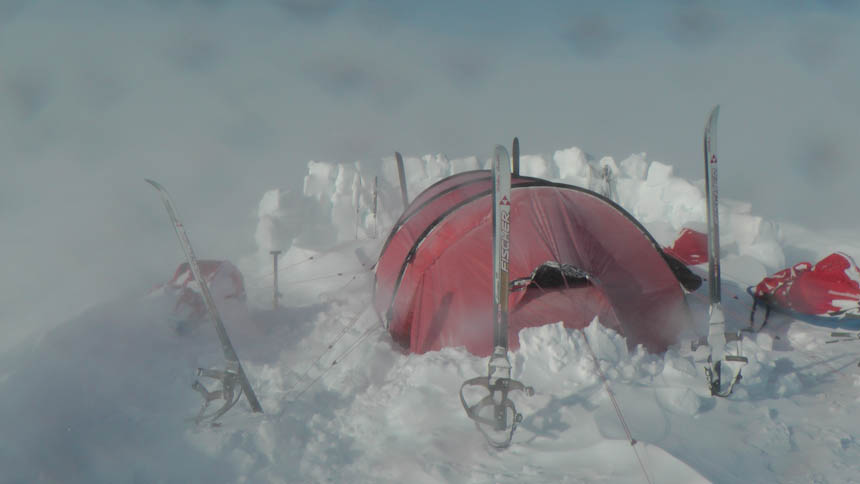
6km from the Inuit community we came to an area that the snow was a bit wet. I was ahead, so I tested the ground first, by stabbing hard with my poles before stamping down with a ski whilst supporting my weight on a safe area. It was a bit wet but felt solid enough. We could not see too far in front, or indeed the valley sides, thus had little idea of our position. It was not clear whether this area was local or extended – we had no reference. I moved tentatively onto the ice which held my weight well, so I continued slowly onwards, testing out the ice all the while.
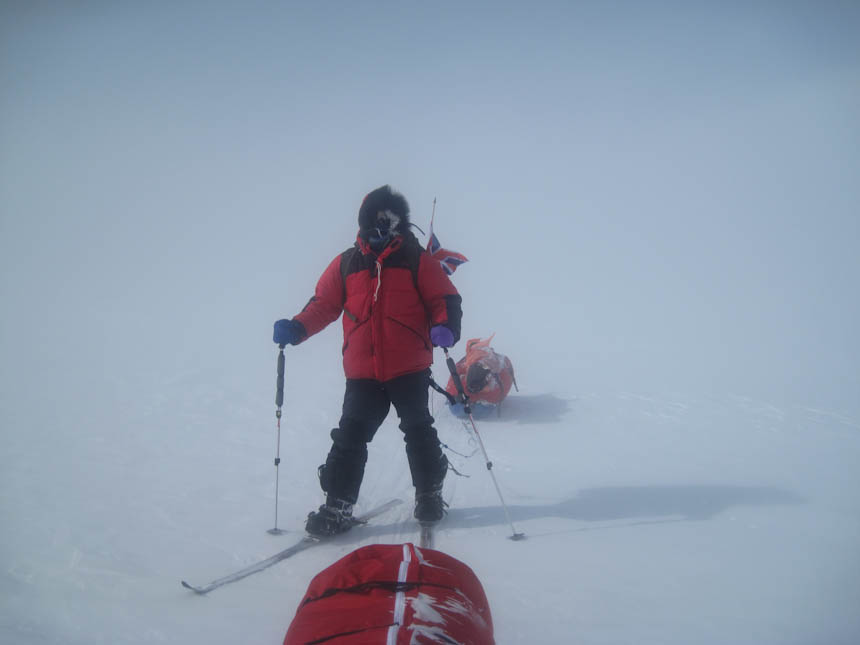
I had not advanced more than 50 metres before I heard shouting behind me. I whipped around to see Antony, seemingly okay. ‘Wait! Where’s Duncan?’ Twisting myself to look down, I saw a broken section of ice and Duncan in the middle of an opening. My tracks had weakened the thin ice and his extra weight had cracked it, dropping him, skis and all, into the freezing waters beneath. His pulk fortunately was still on the ice, far enough behind him to not fall through and drag him under, and the opening not large enough to take his arms, which were extended further by ski poles, holding his upper body out of water.
My initial reaction was to go back to help. Antony, however, having had previous experience with thin ice through training courses and his recent North Pole expedition, quickly took charge and stopped me from approaching, shouting “STAY STILL!” Which was obvious when thinking rationally, as the weight of another person over the thin and weak ice could have further increased the opening, or even led to that person falling in, worsening the situation considerably. The best solution was if Duncan could drag himself out of the hole and onto the surrounding ice. Time was of the essence as it would only take a couple of minutes before he became too cold to help himself. We watched as he used his arms and poles on the ice, clawing to gain purchase and started to drag himself out. He was heavily burdened by his skis and heavy water laden clothing making the task even more difficult. The opening opened further as he pushed against the edge. Rallying himself further he pushed through to the newly formed edge. This time it held and he was finally on his hands and knees, next to the hole. Even though he was out of the water and the immediate danger had been averted we were still on perilous ground. How weak was this area? How far did it stretch? And meanwhile Duncan was becoming colder and colder. The wind buffeted us, whipping the heat from his soaking wet clothing.
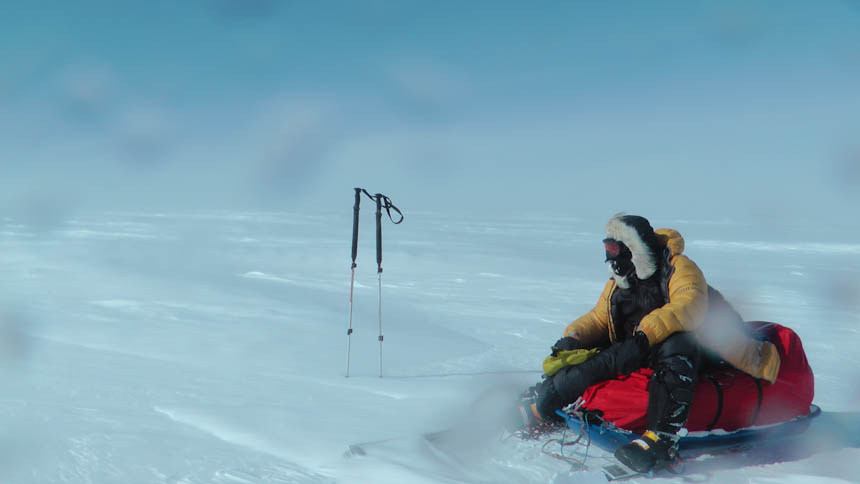
We moved off quickly, no longer following each other’s traces, each of us on a separate line in order to travel over ice that had not been weakened. We stabbed each point with our ski poles to check the solidity of the ice. At one point I felt my left ski punch through. I reacted quickly, switching my weight onto my poles and right foot, so only my left foot dipped into the water, fortunately well below the waterproof line. I took it out and sidestepped onto safer ground. We continued apace for about 10 minutes until we were sure we were on safer, thicker ice, then stopped to evaluate the situation. I looked down and was astonished to see the water that had remained on my boot had frozen up and collected a large amount of snow from the spindrift, in complete contrast to my black dry right boot. Duncan reported that the whole of his lower body was wet. His boots were filled with water, and his lower upper body was also soaked. This was dangerous – the cold water alone was problematic enough, but having wet clothing was even more so, as when wet, it becomes very inefficient at insulating. He was getting cold.
After such an event, the human body immediately releases adrenaline, allowing the body to cope with exceptional circumstances. Duncan’s body at this stage would have been pumping adrenalin, providing him with more energy and faster reactions. This adrenalin rush does not last long however, and is often followed by fatigue. Mentally though everyone acts differently. Keeping his morale up was essential to ensure he used what reserves his body had to cope with the situation. That was our job.
We joked with him about the incident, jokingly becoming upset that he had managed to have a wash whilst we both were still smelly in three-week-old clothing. We pushed onwards, increasing our speed in order to force Duncan’s body to keep generating the heat that would keep him warm. This strategy is normally only possible for a couple of hours, while the adrenalin was still in his body, giving him the energy to keep going. After this we would need to stop and probably make camp in order for him to get out of his cold, wet clothing and warm up in the tent. Fortunately for us we were only a few hours from the community, allowing us to make ‘somewhere warm and inside’ our direct aim and indeed an objective to keep Duncan focussed on. He was in good spirits, complaining little and moving well with the new pace we set through the blizzard. Antony was in front and I stayed behind as we pushed on, again involuntarily meandering through the whiteout.
Another hour passed. We continued on, knowing from the GPS that we were not far away but with no visual reference. “Getting cold now” said Duncan cheerfully as I again complained that he’d managed to wash and that I was so desperately dirty. From his relative lack of complaints, I took note that Duncan was probably getting very cold and pushed him further to catch up with Antony, who was now further in front. We were getting tired, having had no rest in the last few hours. But we knew we must be close, and we were traveling fast, in the right(ish) direction. Finally, a slight parting of the clouds, and we saw the unmistakable dark silhouettes of buildings directly to our left. Pangnirtung.
It still took about 30 minutes of frenzied skiing to find the frozen harbour and haul ourselves into the main town. The end in sight gave us new energy but Duncan fell a few times now, tripping up on the steep ground – the cold undeniably affecting his concentration. We parked our sledges by the national park office and made a beeline for the local cafe. Water flooded out of Duncan’s boots as he yanked them off, his socks dripping. The coffee and chips arrived soon after, steaming hot. A bite and a slurp later, a huge grin appeared on Duncan’s face. “We’ve done it!”